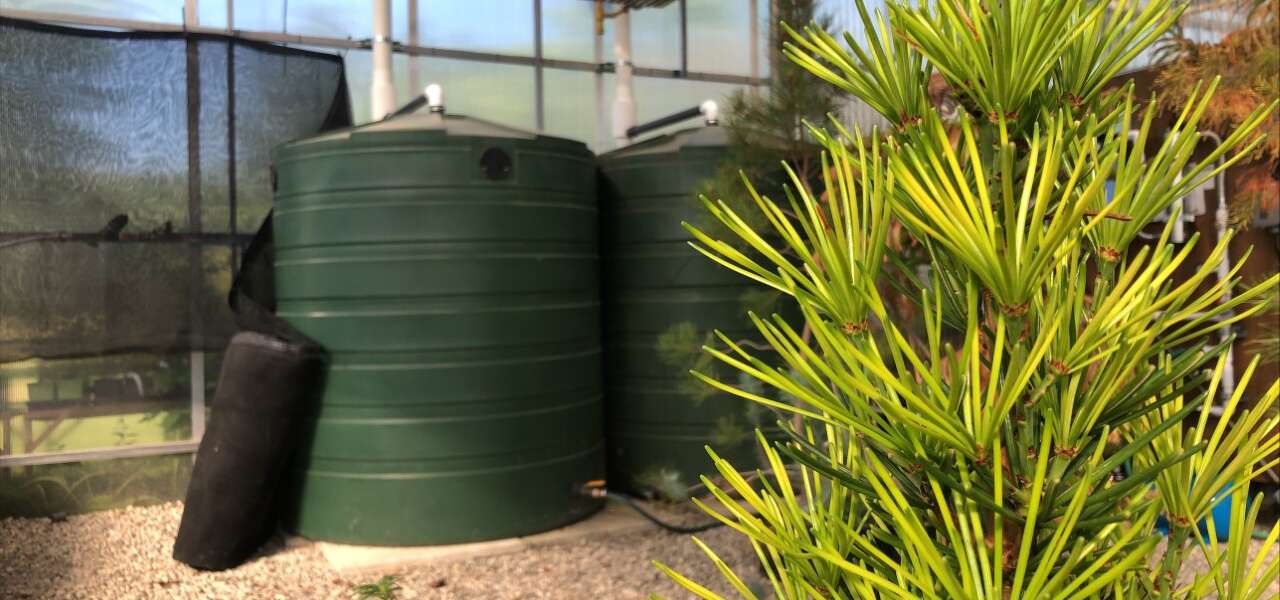Conserving city groundwater while nurturing plants and gardens at the University of Guelph Arboretum is the dual purpose of a rainwater harvesting system upgraded this month at a campus greenhouse.
The project – which collects thousands of litres’ worth of rainfall instead of tapping local groundwater resources – follows last year’s installation of a separate system at the arboretum’s demonstration gardens intended to promote rainwater harvesting among city residents.
Resource stewardship drives both initiatives, said arboretum director Justine Richardson.
“Rainwater is especially important for our seedlings and propagation trials and misting table, and sustainability measures are essential to our operations,” she said. “Harvesting rainwater means less pressure on the water table. Collecting water from the atmosphere and using it in our operations is better for our plants and the planet.”
Rainwater is filtered through a UV purification mechanism

This year’s project completed upgrades to a rainwater collection system that stores about 6,500 litres of water at the Henry Kock Propagation Centre greenhouse on College Avenue.
In a virtual closed loop, water collected from the greenhouse roof year-round in storage tanks will be filtered through a new UV purification mechanism and used to irrigate plants grown inside the building, said Garrett Tribble, a 2014 U of G grad and construction manager with WaterFarmers Urban Agriculture in Guelph.
In a related project, his firm this year has also installed a 13,000-litre tank to hold irrigation water drawn from a campus well for propagation use in the greenhouse and nursery during dry periods of the year. The entire system, including pumps and filters, is now running.
Elsewhere in the arboretum, WaterFarmers installed a harvesting system in 2021 that collects rainwater runoff from the J.C. Taylor Nature Centre to irrigate nearby demonstration gardens frequented by arboretum visitors.
That demonstration system – called RainWaterOne – was funded partly by Wellington County through a “Seeding Our Food Future” circular economy grant administered by Innovation Guelph.
Water to irrigate arboretum seedlings

Established near the Gosling Wildlife Gardens, the seasonal rainwater harvesting demo is meant to introduce the concept to visitors.
“The arboretum is a great location for this demo because of its popularity in the community and high foot traffic,” said Alexandra Marson, stormwater service program coordinator in the city’s engineering and transportation services department.
“Using rainwater for lawn and garden watering saves residents money, is better for plants, helps conserve Guelph’s groundwater and reduces demand on municipal stormwater infrastructure.”
She said city residents have collected an average of about $700 in city rebates for installing rainwater harvesting systems. Rebates may reach up to $2,000, depending on the size of the collection tank installed.
Richardson said the arboretum has received numerous inquiries about the system.
Housed inside a wooden enclosure, the plastic, 1,000-litre demonstration tank at the nature centre is fed by eavestrough downspouts from a roof that was originally intended to accommodate solar panels. Those panels were never installed.
“We’re excited that that funky-angled roof from 1978 can now be used for sustainability measures by collecting rainwater,” she said.
WaterFarmers works with homeowners and other clients on a range of food production and “eco-landscaping” projects. In 2017 and 2018, the company teamed up with U of G on an aquaponics demonstration at the Royal Agricultural Winter Fair in Toronto.
Contact:
Barb Ash
U of G Arboretum
bash@uoguelph.ca
